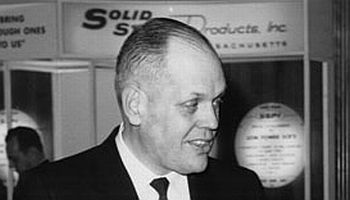Gordon College and the family of tech pioneer Ken Olsen, announced the death of the 84-year old who played a major role in shaping the IT industry. The cause of death has not been given.
Olsen founded Digital Equipment Corporation (DEC), in 1957, after leaving MIT. He had graduated from the college in 1950 with a BSc and went on to receive an MA in 1952. After that he worked in MIT’s computer laboratory where he learnt how computers could be built from modules.
The Rise And Fall Of DEC

In 1956 he decided to strike out into his own business with his brother Stan and his college friend Harlan Anderson. The trio were funded by venture capital firm American Research and Development Corporation to the tune of $75,000 (£47,000) which Olsen claimed lasted the company for eight years.
On the founding of DEC, the trio immersed themselves in producing computer modules that could be configured in various ways for research work. Soon, they had built a reputation for producing circuitry that worked faster than their competitors and the time was ripe for the second phase of the company’s development – the production of DEC’s first computer, the PDP-1.
The PDP-1 was a low-cost machine for its day, priced at $110,000. (£70,000) and was more interactive than the IBM mainframes that required punched cards rather than programs to operate. Even though the PDP range of “minicomputers” was a lot less powerful than the mainframes IBM was producing, they had a much larger market and soon DEC became second to IBM in the manufacturing business.
Under Olsen’s leadership, the company became a pioneer of many of the technologies we take for granted today. It developed tape back-up systems, based on a technology he brought from MIT. The company was also a major player in the evolution of Ethernet networks, developed originally by Xerox’s Palo Alto Research Center (Parc). This led to the development of computer clustering long before Microsoft hijacked the technology as one of its own “innovations”.
Dave Cutler who is a major force in Microsoft and an architect of older Windews versions including NT, made his name at DEC when he developed an operating system for the PDP-11, VMS. This led to the development of clustering.
Cutler’s big production at Microsoft, Windows NT, was disparagingly described as “VMS with the security taken out” by DEC employees from its inception.
Outspoken Critic Of IT

Olsen will be remembered not only as a pioneer of IT but also as a man who spoke his mind, making him popular with the press for his occasionally wild observations. Several quotes have been attributed to him and often misinterpreted.
He habitually referred to Unix as “snake oil”, the cure-all sold by conmen at American medicine shows. Despite this, he did not over-rule the use of the operating system and a version of Unix (called Ultrix) was developed to run on the PDP and DEC VAX systems, the successor to the PDP range.
He is also widely quoted as saying, “There is no reason for any individual to have a computer in his home.” Today this might sound rather naïve but Olsen contested that it was taken out of context, and referred to the futuristic computerised homes which were often shown in the 1970s and 1980s.
Like Cutler, he had a sardonic sense of humour and once said, “The nicest thing about standards is that there are so many of them to choose from.”
He also predicted the rise of cloud computing – though the current implementation was not his main concern. In 1992 he said, “People will get tired of managing personal computers and will want instead terminals, maybe with windows.”
Substitute “browser” or “apps” for “windows” and the concept of today’s multitude of clients becomes obvious. He was talking of “windows” generically of course, not the Microsoft operating system, at the time in its early stages.
Olsen was born in Connecticut, USA, in 1926. The son of a Norwegian father and Swedish mother. He ran DEC from 1956 until 1992 and later saw the ailing company finally fall into the hands of Compaq (1998), which itself was acquired by HP (2002).
Perhaps the greatest achievement for Olsen is the fact that the workhorse PDP-11 can still be found controlling and monitoring factories, transportation systems and nuclear plants 30 years after its introduction in 1970. HP’s tape storage system is a development of the tape system introduced in DEC’s founding years.





